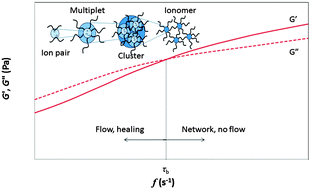Connecting supramolecular bond lifetime and network mobility for scratch healing in poly(butyl acrylate) ionomers containing sodium, zinc and cobalt
Abstract
In this work, we correlate network dynamics, supramolecular reversibility and the macroscopic surface scratch healing behavior for a series of elastomeric ionomers based on an amorphous backbone with varying fractions of carboxylate pendant groups completely neutralized by Na+, Zn2+ or Co2+ as the counter ions. Our results based on temperature dependent dynamic rheology with simultaneous FTIR analysis clearly indicate that the effective supramolecular bond lifetime (τb) is an important parameter to ascertain the ideal range of viscoelasticity for good macroscopic healing. The reversible coordination increased with higher valence metal ions and ionic content. Both rheological and spectroscopic analyses show a decrease in supramolecular assembly with temperature. The temperature dependent τb was used to calculate the activation energy (Ea) of dissociation for the ionic clusters. According to self-healing experiments based on macroscale surface scratching, a supramolecular bond lifetime between 10 and 100 s results in samples with complete surface scratch healing and good mechanical robustness.


 Please wait while we load your content...
Please wait while we load your content...